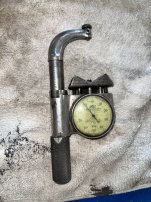I was told the instrument in the attached picture is a crankshaft journal “roundness” micrometer.
The major graduations on the adjustable stem are in 1” and the minor graduations on are in 1/10”. Graduations on the dial indicator are in 1/1000”. There is what appears to be a calibration screw on the jaw opposite the plunger of the dial indicator. The plunger protrudes through the spring loaded cradle.
I’m puzzled about the calibration and use of this instrument. As the diameter of an object in the cradle changes so will the calibration. Is anyone familiar with this instrument, its use, and most importantly, its calibration?
The major graduations on the adjustable stem are in 1” and the minor graduations on are in 1/10”. Graduations on the dial indicator are in 1/1000”. There is what appears to be a calibration screw on the jaw opposite the plunger of the dial indicator. The plunger protrudes through the spring loaded cradle.
I’m puzzled about the calibration and use of this instrument. As the diameter of an object in the cradle changes so will the calibration. Is anyone familiar with this instrument, its use, and most importantly, its calibration?


